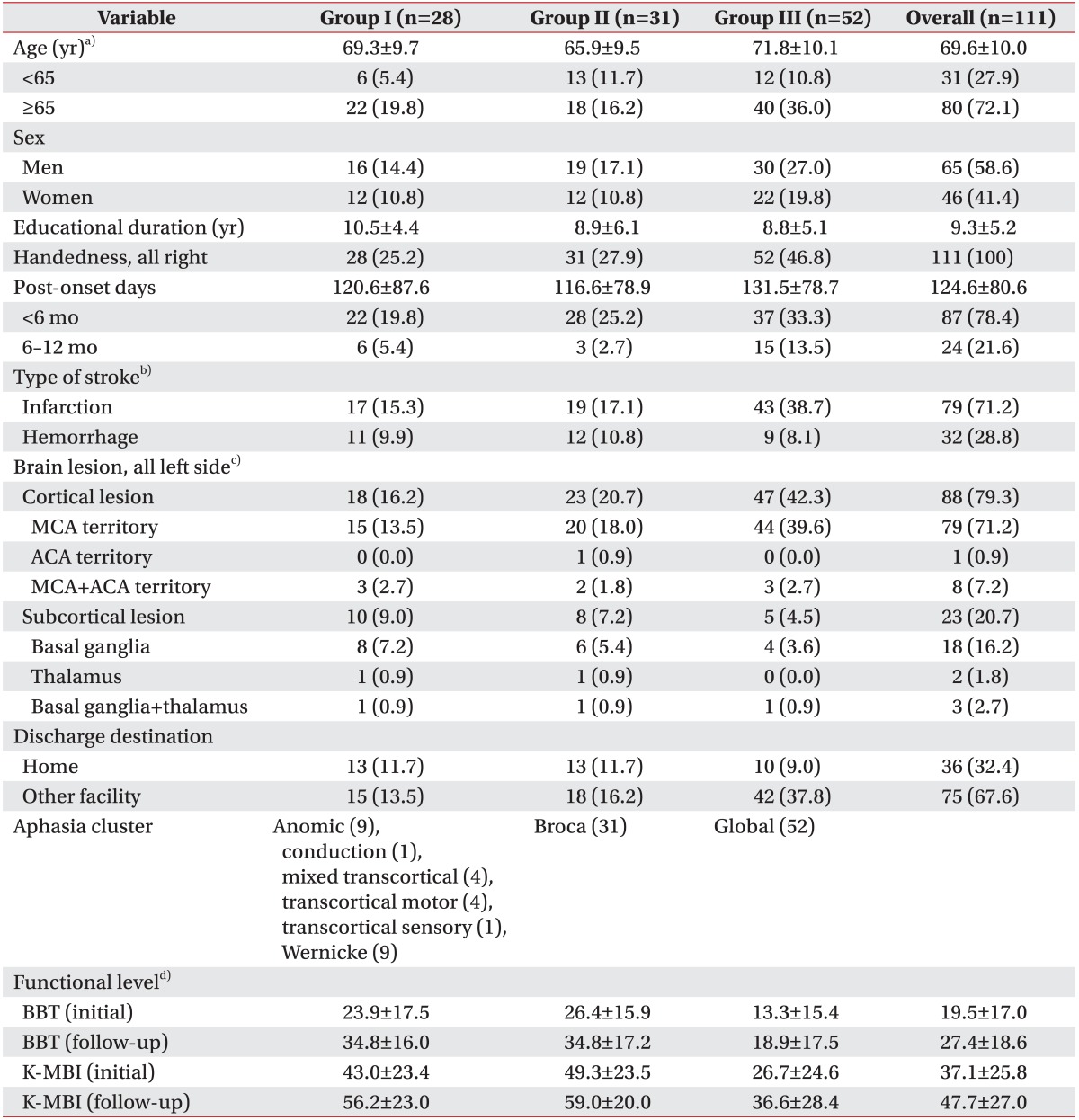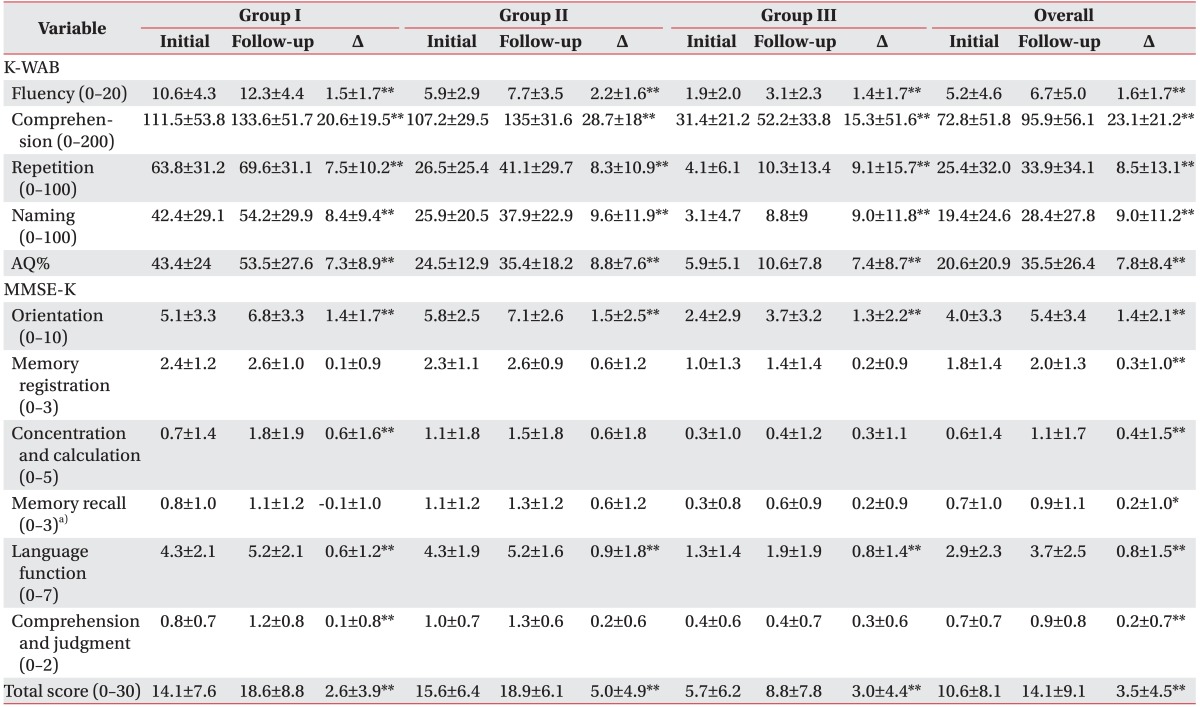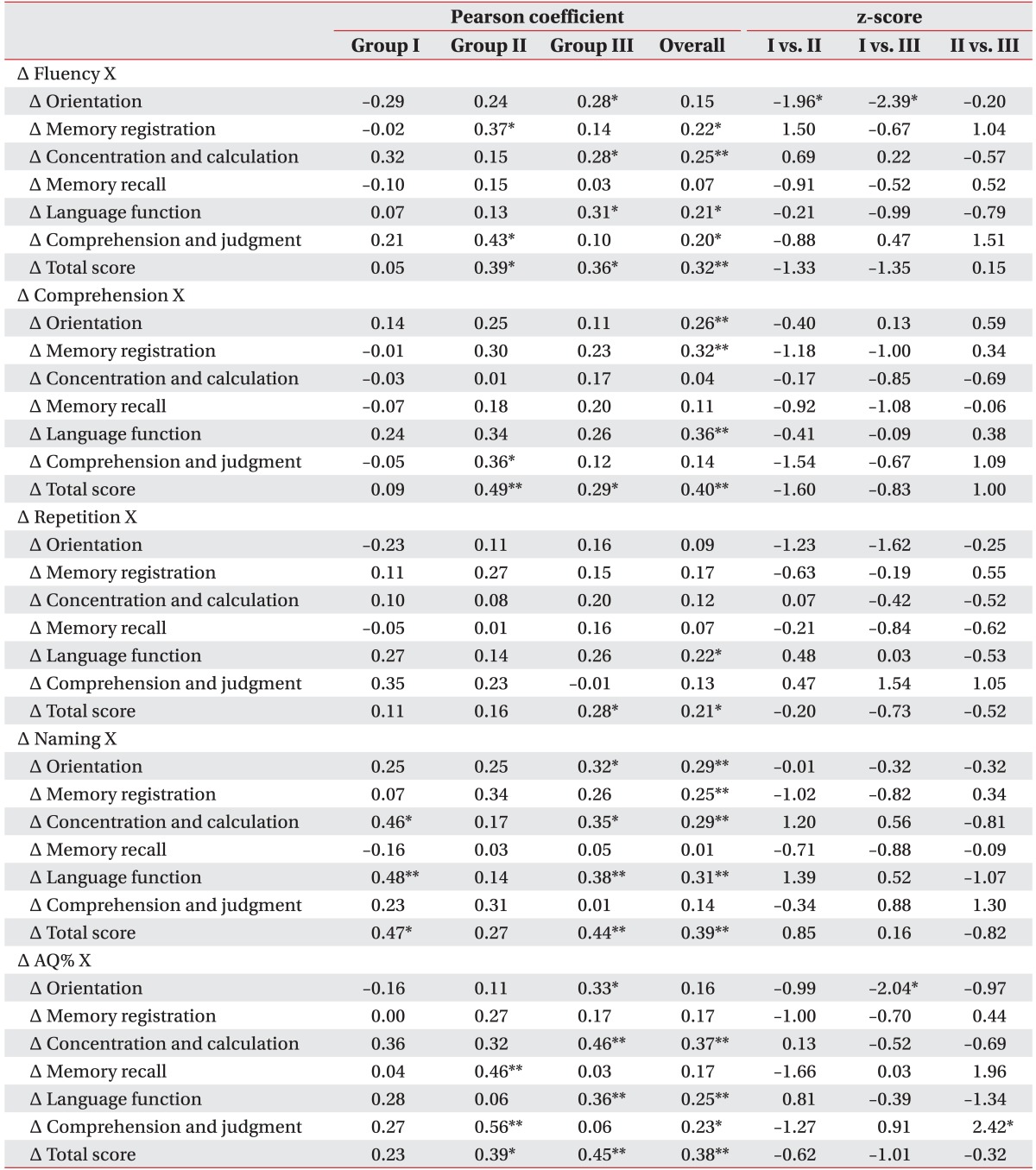1. Wagle J, Farner L, Flekkoy K, Bruun Wyller T, Sandvik L, Fure B, et al. Early post-stroke cognition in stroke rehabilitation patients predicts functional outcome at 13 months. Dement Geriatr Cogn Disord. 2011; 31:379–387. PMID:
21720162.

2. Sinanovic O, Mrkonjic Z, Zukic S, Vidovic M, Imamovic K. Post-stroke language disorders. Acta Clin Croat. 2011; 50:79–94. PMID:
22034787.
3. Park JH, Kim BJ, Bae HJ, Lee J, Lee J, Han MK, et al. Impact of post-stroke cognitive impairment with no dementia on health-related quality of life. J Stroke. 2013; 15:49–56. PMID:
24324939.

4. El Hachioui H, Visch-Brink EG, Lingsma HF, van de Sandt-Koenderman MW, Dippel DW, Koudstaal PJ, et al. Nonlinguistic cognitive impairment in poststroke aphasia: a prospective study. Neurorehabil Neural Repair. 2014; 28:273–281. PMID:
24213963.
5. Yu ZZ, Jiang SJ, Bi S, Li J, Lei D, Sun LL. Relationship between linguistic functions and cognitive functions in a clinical study of Chinese patients with post-stroke aphasia. Chin Med J (Engl). 2013; 126:1252–1256. PMID:
23557554.
6. Lee B, Pyun SB. Characteristics of cognitive impairment in patients with post-stroke aphasia. Ann Rehabil Med. 2014; 38:759–765. PMID:
25566474.

7. Kwon JY, Kim JS, Park SW, Jang SJ, Kim BS. Influence of aphasia on the cognitive screening test in stroke patients with unilateral cerebral hemispheric lesion. J Korean Acad Rehabil Med. 2002; 26:9–13.
8. Rice ML. Contemporary accounts of the cognition/language relationship: implications for speech-language clinicians. J Speech Hear Disord. 1983; 48:347–359. PMID:
6645429.
9. Tatemichi TK, Desmond DW, Stern Y, Paik M, Sano M, Bagiella E. Cognitive impairment after stroke: frequency, patterns, and relationship to functional abilities. J Neurol Neurosurg Psychiatry. 1994; 57:202–207. PMID:
8126506.

10. Katz N, Itzkovich M, Averbuch S, Elazar B. Loewenstein Occupational Therapy Cognitive Assessment (LOTCA) battery for brain-injured patients: reliability and validity. Am J Occup Ther. 1989; 43:184–192. PMID:
2735378.

11. Pedersen PM, Jorgensen HS, Nakayama H, Raaschou HO, Olsen TS. Aphasia in acute stroke: incidence, determinants, and recovery. Ann Neurol. 1995; 38:659–666. PMID:
7574464.

12. Lazar RM, Minzer B, Antoniello D, Festa JR, Krakauer JW, Marshall RS. Improvement in aphasia scores after stroke is well predicted by initial severity. Stroke. 2010; 41:1485–1488. PMID:
20538700.

13. Raven J. Raven progressive matrices. In : McCallum RS, editor. Handbook of nonverbal assessment. New York: Kluwer Academic/Plenum Publishers;2003. p. 223–237.
14. Helm-Estabrooks N. Cognition and aphasia: a discussion and a study. J Commun Disord. 2002; 35:171–186. PMID:
12036150.

15. Kwon YC, Park JH. Korean version of Mini-Mental State Examination (MMSE-K). Part I: development of the test for the elderly. J Korean Neuropsychiatr Assoc. 1989; 28:125–135.
16. Park JH, Kwon YC. Standardization of Korean version of the Mini-Mental State Examination (MMSE-K) for use in the elderly. Part II: diagnostic validity. J Korean Neuropsychiatr Assoc. 1989; 28:508–513.
17. Guerrero-Berroa E, Luo X, Schmeidler J, Rapp MA, Dahlman K, Grossman HT, et al. The MMSE orientation for time domain is a strong predictor of subsequent cognitive decline in the elderly. Int J Geriatr Psychiatry. 2009; 24:1429–1437. PMID:
19382130.

18. Kim H, Na DL. Paradise-Korean version of the Western Aphasia Battery. Seoul: Paradise Welfare Foundation;2001.
19. Kertesz A, Poole E. The aphasia quotient: the taxonomic approach to measurement of aphasic disability. Can J Neurol Sci. 1974; 1:7–16. PMID:
4434266.

20. Kertesz A. Aphasia and associated disorders: taxonomy, localization, and recovery. New York: Grune & Stratton;1979.
21. Katz N, Elazar B, Itzkovich M. Construct validity of a geriatric version of the Loewenstein Occupational Therapy Cognitive Assessment (LOTCA) battery. Phys Occup Ther Geriatr. 1995; 13:31–46.

22. Katz N, Hartman-Maeir A, Ring H, Soroker N. Relationships of cognitive performance and daily function of clients following right hemisphere stroke: predictive and ecological validity of the LOTCA battery. OTJR (Thorofare N J). 2000; 20:3–17.

23. Folstein MF, Folstein SE, McHugh PR. "Mini-mental state": a practical method for grading the cognitive state of patients for the clinician. J Psychiatr Res. 1975; 12:189–198. PMID:
1202204.
24. Oldfield RC. The assessment and analysis of handedness: the Edinburgh inventory. Neuropsychologia. 1971; 9:97–113. PMID:
5146491.

25. Martinez IN, Moran JM, Pena FJ. Two-step cluster procedure after principal component analysis identifies sperm subpopulations in canine ejaculates and its relation to cryoresistance. J Androl. 2006; 27:596–603. PMID:
16582416.

26. Preacher KJ. Calculation for the test of the difference between two independent correlation coefficients [Internet]. [place unknown]: [publisher unknown];2002. cited 2016 Jan 15. Available from:
http://www.quantpsy.org/corrtest/corrtest.htm.
27. Cohen J, Cohen P, West SG, Aiken LS. Applied multiple regression/correlation analysis for the behavioral sciences. 3rd ed. Hoboken: Taylor and Francis;2013.
28. Kalaria RN, Ballard C. Stroke and cognition. Curr Atheroscler Rep. 2001; 3:334–339. PMID:
11389800.

29. Dominey PF, Hoen M, Blanc JM, Lelekov-Boissard T. Neurological basis of language and sequential cognition: evidence from simulation, aphasia, and ERP studies. Brain Lang. 2003; 86:207–225. PMID:
12921765.

30. Massaro DW. Understanding language: an information-processing analysis of speech perception, reading, and psycholinguistics. New York: Academic Press;1975.
31. Tombaugh TN, McIntyre NJ. The mini-mental state examination: a comprehensive review. J Am Geriatr Soc. 1992; 40:922–935. PMID:
1512391.

32. Schultz-Larsen K, Kreiner S, Lomholt RK. Mini-Mental Status Examination: mixed Rasch model item analysis derived two different cognitive dimensions of the MMSE. J Clin Epidemiol. 2007; 60:268–279. PMID:
17292021.

33. Lee HJ, Choi HY, Yun KW, Kim YC, Lim WJ, Kim JH, et al. Association between Obesity Indices and MMSE-K in elderly. J Korean Neuropsychiatr Assoc. 2013; 52:447–453.

34. Feher EP, Mahurin RK, Doody RS, Cooke N, Sims J, Pirozzolo FJ. Establishing the limits of the Mini-Mental State. Examination of 'subtests'. Arch Neurol. 1992; 49:87–92. PMID:
1728269.
35. Pedersen PM, Vinter K, Olsen TS. Aphasia after stroke: type, severity and prognosis: the Copenhagen aphasia study. Cerebrovasc Dis. 2004; 17:35–43. PMID:
14530636.
36. Pedersen PM, Jorgensen HS, Nakayama H, Raaschou HO, Olsen TS. Orientation in the acute and chronic stroke patient: impact on ADL and social activities. The Copenhagen Stroke Study. Arch Phys Med Rehabil. 1996; 77:336–339. PMID:
8607755.

37. Sinyor D, Amato P, Kaloupek DG, Becker R, Goldenberg M, Coopersmith H. Post-stroke depression: relationships to functional impairment, coping strategies, and rehabilitation outcome. Stroke. 1986; 17:1102–1107. PMID:
3810708.

38. Berthier ML, Green C, Higueras C, Fernandez I, Hinojosa J, Martin MC. A randomized, placebo-controlled study of donepezil in poststroke aphasia. Neurology. 2006; 67:1687–1689. PMID:
17101908.

39. Wong IC, Lhatoo SD. Adverse reactions to new anticonvulsant drugs. Drug Saf. 2000; 23:35–56. PMID:
10915031.







 PDF
PDF ePub
ePub Citation
Citation Print
Print



 XML Download
XML Download